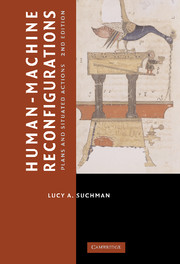Book contents
- Frontmatter
- Contents
- Acknowledgments
- Preface to the 2nd Edition
- Introduction
- 1 Readings and Responses
- 2 Preface to the 1st Edition
- 3 Introduction to the 1st Edition
- 4 Interactive Artifacts
- 5 Plans
- 6 Situated Actions
- 7 Communicative Resources
- 8 Case and Methods
- 9 Human–Machine Communication
- 10 Conclusion to the 1st Edition
- 11 Plans, Scripts, and Other Ordering Devices
- 12 Agencies at the Interface
- 13 Figuring the Human in AI and Robotics
- 14 Demystifications and Reenchantments of the Humanlike Machine
- 15 Reconfigurations
- References
- Index
- Frontmatter
- Contents
- Acknowledgments
- Preface to the 2nd Edition
- Introduction
- 1 Readings and Responses
- 2 Preface to the 1st Edition
- 3 Introduction to the 1st Edition
- 4 Interactive Artifacts
- 5 Plans
- 6 Situated Actions
- 7 Communicative Resources
- 8 Case and Methods
- 9 Human–Machine Communication
- 10 Conclusion to the 1st Edition
- 11 Plans, Scripts, and Other Ordering Devices
- 12 Agencies at the Interface
- 13 Figuring the Human in AI and Robotics
- 14 Demystifications and Reenchantments of the Humanlike Machine
- 15 Reconfigurations
- References
- Index
Summary
In this age, in which social critics complain about the replacement of men by machines, this small corner of the social world has not been uninvaded. It is possible, nowadays, to hear the phone you are calling picked up and hear a human voice answer but nevertheless not be talking to a human. However small its measure of consolation, we may note that even machines such as the automatic answering device are constructed on social, and not only mechanical, principles. The machine's magnetic voice will not only answer the caller's ring, but will also inform him when its ears will be available to receive his message, and warn him both to wait for the beep and confine his interests to fifteen seconds.
(Shegloff 1972: 374)Chapter 9 describes people's first encounters with a machine called an expert help system; a computer-based system attached to a large and relatively complex photocopier and intended to instruct the user of the copier in its operation. The system's identification as an expert help system both locates it in the wider category of so-called expert systems and indicates that a function of this system is to provide procedural instructions to the user. The idea of expert systems in general is that expertise consists in a body of propositions or “knowledge” about a particular domain and rules for its use.
- Type
- Chapter
- Information
- Human-Machine ReconfigurationsPlans and Situated Actions, pp. 109 - 124Publisher: Cambridge University PressPrint publication year: 2006

